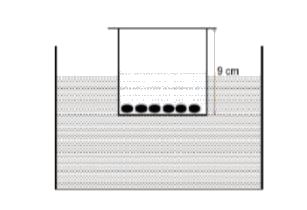A particle starts moving along a line from zero initial velocity and comes to rest after moving distance d. During its motion it had a constant acceleration f over 2/3 of the distance, and covered the rest of the distance with constant retardation. The time taken to cover the distance is
√2d/3f
2√d/3f
√3d/f
√3d/2f
The correct Answer is:C
Step by step video, text & image solution for A particle starts moving along a line from zero initial velocity and comes to rest after moving distance d. During its motion it had a constant acceleration f over 2/3 of the distance, and covered the rest of the distance with constant retardation. The time taken to cover the distance is by Physics experts to help you in doubts & scoring excellent marks in Class 12 exams.
Updated on:21/07/2023Topper's Solved these Questions
Similar Questions
A wide bottom cylindrical massless plastic container of height 9 cm has 40 identical coins inside it and is floating on water with 3 cm inside the water. If we start putting more of such coins on its lid. It is observed that after N coins are put, its equilibrium changes from stable to unstable. Equilibrium in floating is stable if the geometric center of the submerged portion is above the center of mass of the object) The value of N is closed to

View SolutionA body starts from rest and moves with constant acceleration. The ratio of distance covered by the body in nth second to that covered in n second is.
View SolutionA particle starts from rest and traverses a distance l with uniform acceleration, then moves uniformly over a further distance 2l and finally comes to rest after moving a further distance 3l under uniform retardation. Assuming entire motion to be rectilinear motion the ratio of average speed over the journey to the maximum speed on its ways is
View SolutionA car starts from rest and moves with constant acceleration. In first t seconds it covers distance x. Then distance covered by it in next t seconds will be:-
View SolutionA car, starting from rest, moves in a straight line with constant acceleration . 4m//s^(2) After some time, it immediately starts retarding at constant rate 2m//s^(2) until it comes to rest. If the car moved for a total time 18 seconds, the total distance covered is
View SolutionA particle starts moving in a straight from rest with constant acceleration until it reaches velocity v. The distance travelled by it until this point is . Then, it covers a further distance x at constant velocity. Finally, it slows down to rest at a constant rate such that it covers distance 2x. The total time for which the particle moved is T .Then ,(Tv)/(x)=
View SolutionA particle starts from rest and traverses a distance 2x with uniform acceleration, then moves uniformly over a further distance 4x and finally comes to rest after moving a further distance 6x under uniform retardation. Assuming entire motion to be rectilinear motion, the ratio of average speed over the journey to the maximum speed on its way is
View SolutionA particle at rest starts moving in a horizontal straight line with a uniform acceleration. The ratio of the distances covered during the fourth and third seconds is
View SolutionA car starts from rest and moves with constant acceleration. The ratio of distance covered by the car in nth second with that covered in n seconds is:
View SolutionA body moving with the constant retardation d loses 23of its initial velocity w What is the distance covered by the body in the time during which it occurs ?
View SolutionA particle at rest starts moving in a horizontal straight line with uniform acceleration The ratio of the distance covered during the fourth and the third second is
View SolutionA body starting from rest moves with constant acceleration. What is the ratio of distance covered by the body during the fifth second of time to that covered in the first 5.00 s ?
View SolutionA body of mass m starts moving from a position of rest with a constant acceleration a. After covering a distance, it has acquired velocity v. What will be the magnitude of its velocity after it has covered a distance 2s?
View SolutionA car starts from rest and moves with constant acceleration. The ratio of the distance covered in the nth second to that covered in n seconds is
View SolutionA particle starts from rest and traverses a distance l with uniform acceleration, then moves uniformly over a further distance 2l and finally comes to rest after moving a further distance 3l under uniform retardation. Assuming entire motion to be rectilinear motion the ratio of average speed over the journey to the maximum speed on its ways is
View Solution
